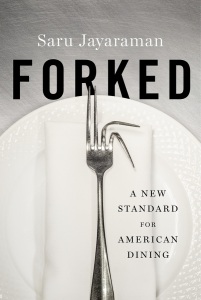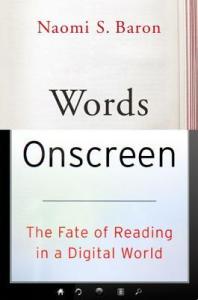Forked: A New Standard for American Dining
Saru Jayaraman
Having spent nearly half of my working life in restaurants, I was excited to read Jayaraman’s defense of the American service worker — especially since I was once employed by two of what she considers to be two of the worst employers in the biz: Olive Garden and Red Lobster.
service worker — especially since I was once employed by two of what she considers to be two of the worst employers in the biz: Olive Garden and Red Lobster.
Many of the back-of-the-house anecdotes in Forked are all too familiar to me, but Jayaraman, through her research and foundation, Restaurant Opportunities Center, augments these tales with stats and studies and facts that I, even as a fairly well-informed server/bartender/cook/dishwasher, didn’t realize. These include the history of the tipped economy and why it has lost favor in much of the world and that the federal minimum wage has remained at $2.13 an hour for nearly a quarter-century for those living off gratuities.
Jayaraman argues that the industry and its workers remain handcuffed by mid-1990s legislation put forth by Herman Cain, the National Restaurant Association, and Darden Restaurants, the largest restaurant company in the world. Darden’s flagship chain is the Olive Garden, and until 2014 it also owned Red Lobster.
Of the restaurants where I’ve worked, Darden’s were actually the nicest, which is more commentary on the sad state of the industry than a compliment to Darden. Jayaraman has an even lower opinion of their stores. In each section of Forked, she profiles a company taking the high road in its treatment of workers and a company taking the low road.
Not even unlimited cheddar bay biscuits could salvage a passing grade for Darden.
For me, the most illuminating aspect of Jayaraman’s manifesto is her discussion of sexual harassment. Now, it’s no secret (I don’t think) that restaurants are sexually charged work milieus. They are also an intersection of diverse populations. The back of the house, in my experience, was a mix of drifters, creative types, future scholars and criminals. Many of my co-workers went on to earn advanced degrees. Many of them came to work wearing house arrest anklets.
Meanwhile, the front of the house was mostly staffed by young women, some of them still in high school, who drew the salacious humor and advances of the boys’ club on the line. Some of it was naive or good-natured (I’m thinking of the potty humor and clumsy communication of teenaged boys), but some of it was creepy and misogynistic.
And all of it was inappropriate in the workplace, which is why I haven’t witnessed much of it since leaving the restaurant industry.
But even with this knowledge, Jayaraman’s research was alarming. Consider, she argues, that for millions of young women, hosting or waiting tables is their first job. “It is the industry through which they learn what is tolerable and acceptable in the workplace.”
She backs this up with data (higher rates of sexual harassment in states paying tipped workers differently from non-tipped workers) and anecdotally (women who failed to report sexual harassment in later employment because, compared to what they’d endured, “it was never as bad as it was” in restaurants.
But for all there is to recommend Forked, there is a bias that must be acknowledged. The book promotes the work of ROC, a nonprofit co-founded by Jayaraman, and lacks the outsider perspective of books like Nickel and Dimed and Fast Food Nation.
While this bias is worth keeping in mind, it doesn’t discredit her argument — her research and data are still valid, just maybe not as comprehensive as that of independent lab testing.
That only slightly tempers my enthusiasm for this book. Forked is well-written and informative, and I think it’s a must-read for American diners — especially if they’ve never known the joy of cleaning out the deep fryer.




















